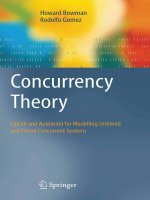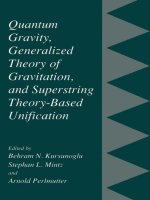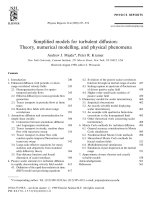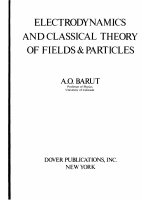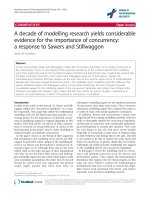Concurrency Theory Howard Bowman and Rodolfo GomezConcurrency TheoryCalculi and Automata potx
Bạn đang xem bản rút gọn của tài liệu. Xem và tải ngay bản đầy đủ của tài liệu tại đây (7.36 MB, 444 trang )
Concurrency Theory
Howard Bowman and Rodolfo Gomez
Concurrency
Theory
Calculi and Automata for Modelling Untimed and Timed
Concurrent Systems
With 126 Figures
Howard Bowman
Rodolfo Gomez
Computing Laboratory
University of Kent at Canterbury
Canterbury
Kent
UK
British Library Cataloguing in Publication Data
A catalogue record for this book is available from the British Library
Library of Congress Control Number: 2005931433
ISBN-10: 1-85233-895-4
ISBN-13: 978-1-85233-895-4
Printed on acid-free paper
© Springer-Verlag London Limited 2006
Apart from any fair dealing for the purposes of research or private study, or criticism or review,
as permitted under the Copyright, Designs and Patents Act 1988, this publication may only be
reproduced, stored or transmitted, in any form or by any means, with the prior permission in writ-
ing of the publishers, or in the case of reprographic reproduction in accordance with the terms of
licences issued by the Copyright Licensing Agency. Enquiries concerning reproduction outside
those terms should be sent to the publishers.
The use of registered names, trademarks, etc. in this publication does not imply, even in the
absence of a specific statement, that such names are exempt from the relevant laws and regulations
and therefore free for general use.
The publisher makes no representation, express or implied, with regard to the accuracy of the
information contained in this book and cannot accept any legal responsibility or liability for any
errors or omissions that may be made.
Printed in the United States of America (MVY)
987654321
Springer Science+Business Media
springer.com
To our friends and families.
Preface
In the world we live in concurrency is the norm. For example, the human body
is a massively concurrent system, comprising a huge number of cells, all simul-
taneously evolving and independently engaging in their individual biological
processing. In addition, in the biological world, truly sequential systems rarely
arise. However, they are more common when manmade artefacts are consid-
ered. In particular, computer systems are often developed from a sequential
perspective. Why is this? The simple reason is that it is easier for us to think
about sequential, rather than concurrent, systems. Thus, we use sequentiality
as a device to simplify the design process.
However, the need for increasingly powerful, flexible and usable computer
systems mitigates against simplifying sequentiality assumptions. A good ex-
ample of this is the all-powerful position held by the Internet, which is highly
concurrent at many different levels of decomposition. Thus, the modern com-
puter scientist (and indeed the modern scientist in general) is forced to think
about concurrent systems and the subtle and intricate behaviour that emerges
from the interaction of simultaneously evolving components.
Over a period of 25 years, or so, the field of concurrency theory has been
involved in the development of a set of mathematical techniques that can
help system developers to think about and build concurrent systems. These
theories are the subject matter of this book.
Our motivation in writing this book was twofold. (1) We wished to synthe-
sise into a single coherent story, a body of research that is scattered across a set
of journal and conference publications. (2) We have also sought to highlight
newer research (mainly undertaken by the authors) on concurrency theory
models of real-time systems. The first of these aspects yields the text book
style of the first three parts of the book, whereas the second has motivated
the approach of the fourth part, which has more of the flavour of a research
monograph.
There are other books on concurrency theory, but these have tended to
have a different focus from this book. Most relevant in this respect are classic
works by Milner on the Calculus of Communicating Systems (CCS) [148],
VIII Preface
Hoare on first generation Communicating Sequential Processes (CSP) [96],
Roscoe on the mature CSP theory [171] and Schneider on Timed CSP [176].
However, all of these have a tighter focus than this book, being directed at
specific theories. Although one point of major focus in this book is the process
calculus LOTOS (which, by the way, has not previously been presented in
book format), our approach is broader in scope than these earlier texts. For
example, we consider both untimed and timed approaches (in the same book),
we highlight the process calculus approach along with communicating finite
and infinite state automata and we present a spectrum of different semantic
theories, including traces, transition systems, refusals and true concurrency
models. The latter of these semantic models being particularly noteworthy,
because the bundle event structure true concurrency theory we consider is not
as well known as it should be.
Another difference with previous concurrency theory texts is that this
book is less focused on proof systems. There are a number of reasons for this.
First, proof systems are not as well behaved in LOTOS as they are in CCS
and CSP; e.g. testing equivalence is not a congruence in LOTOS. Second,
we would argue that the issue of finding complete proof systems has actually
turned out to be less important than once seemed to be the case. This is be-
cause of the development of powerful state-space exploration methods, such
as model-checking and equivalence-checking, which are not proof system de-
pendent. As a reflection of this trend, we also consider finite and infinite state
communicating automata approaches, which have recently taken a prominent
place in concurrency theory, because of their amenability to formal verifica-
tion. These techniques were not considered in the previous process calculus
texts.
Due to the breadth of scope that we have sought in this book, by necessity,
certain topics have had to be treated in less depth than would be optimum.
As just discussed, one of these is the topic of proof systems. In addition, when,
in a denotational style, we interpret recursive definitions semantically, we do
not present the full details of the fixed point theories that we use. However,
at all such points in the text, we give pointers to the required definitions and
include references to complete presentations of the necessary theory.
In terms of target readership, this book is partially a textbook and partially
a research monograph. It is particularly suitable for masters and doctoral level
programmes with an emphasis on parallel processing, distributed systems,
networks, formal methods and/or concurrency in general. We assume a basic
knowledge of set theory, logic and discrete mathematics, as found in a textbook
such as [86]. However, we do include a list of notation to help the reader.
The material presented here has partially grown out of a set of course
notes used in an MSc-level course on formal methods taught in the Computing
Laboratory at the University of Kent. Consequently, we would like to thank
the students who have taken this course over a number of years. The feedback
from these students has helped these notes to be refined, which has, in turn,
benefited this book.
Preface IX
We would also like to thank a number of our academic colleagues with
whom we have discussed concurrency theory and who have contributed to
the development of our understanding of this field. We would particularly like
to mention Juan Carlos Augusto, Gordon Blair, Lynne Blair, Eerke Boiten,
Tommaso Bolognesi, Jeremy Bryans, Amanda Chetwynd, John Derrick, Gior-
gio Faconti, Holger Hermanns, Joost-Pieter Katoen, Rom Langerak, Diego
Latella, Su Li, Peter Linington, Mieke Massink, Tim Regan, Steve Schnei-
der, Marteen Steen, Ben Strulo, Simon Thompson, Stavros Tripakis and Frits
Vaandrager.
In addition, we would like to acknowledge the contribution of the follow-
ing funding bodies who have provided financial support for our concurrency
theory research over the last ten years: the UK Engineering and Physical
Sciences Research Council, British Telecom, the European Union, under the
Marie Curie and ERCIM programmes, Universities UK, through the Overseas
Research Fund, and the Computing Laboratory at the University of Kent.
Finally, we would like to thank Catherine Drury and the Springer publish-
ing team for their efficiency and patience with us.
Canterbury, Kent, UK, Howard Bowman
June 2005 Rodolfo Gomez
X Preface
Notation
The following is an account of some symbols commonly found in this book.
Numbers
N : the natural numbers
Z : the integer numbers
R : the real numbers
R
+
: the positive real numbers
R
+0
: the positive real numbers, including zero
Sets and Functions
|S| : cardinality of (i.e. number of elements in) S
P(S) : powerset of S (i.e. the set of all possible sets containing elements of S)
⊆ (⊂) : set inclusion (proper set inclusion)
∪ (
) : set union (generalised union)
∩ (
) : set intersection (generalised intersection)
\ : set difference
× : Cartesian product: S
1
× S
2
×···×S
n
= {(s
1
,s
2
, ,s
n
) |s
i
∈ S
i
}
−1
: inverse relation: bR
−1
a iff aRb
: domain restriction: given f : D→R,thenfS is s.t. fS : D∩S →Rand
f(x)=fS(x) for all x ∈D∩S
where S, S
1
,S
2
, ···,S
n
are sets, R is a binary relation and f is a function.
Logic
∧ (
) : conjunction (generalised conjunction)
∨ (
) : disjunction (generalised disjunction)
¬ : negation
=⇒ : implication
⇐⇒ : double implication
∀ : universal quantification
∃ : existential quantification
|= : satisfiability relation
General Abbreviations and Acronyms
: “defined as”
iff : “if and only if”
Preface XI
s.t. : “such that”
w.r.t. : “with respect to”
LTS : “Labelled Transition System”
BES : “Bundle Event Structure”
TBES : “Timed Bundle Event Structure”
TTS : “Timed Transition System”
CA : “(finite state) Communicating Automata”
ISCA : “Infinite State Communicating Automata”
TA : “Timed Automata”
DTA : “Discrete Timed Automata”
RSL : “Ready Simulation Logic”
HML : “Hennessy-Milner Logic”
LOTOS : “Language of Temporal Ordering Specification”
CCS : “Calculus of Communicating Systems”
CSP : “Communicating Sequential Processes”
pomset : “partially ordered multiset”
lposet : “labelled partially ordered set”
Process Calculi (Chapters 2,3,4,5,6,9 and 10)
Sets
In LOTOS
Defs : the set of LOTOS definitions
DefList : the set of lists of LOTOS definitions
tDeflist : the set of tLOTOS definition lists
PIdent : the set of process identifiers
Beh : the set of LOTOS behaviours
tBeh : the set of tLOTOS behaviours
Der(B) : the set of behaviours that can be derived from B
Act : the set of actions
L : the set of actions occurring in a given specification
A(B) : the set of actions which arise in B
Gate : the set of gates
SN : the set of semantic notations
SM : the set of semantic mappings
DEV : the set of development relations
T : the set of traces
A
∗
: the set of traces from actions in A
Tr (S) : the set of traces that can be derived from S
LT S : the set of labelled transition systems
TTS : the set of timed transition systems
Ref
B
(σ) : the set of refusals of B after σ
XII Preface
S(B) : the set of (RSL) observations that B can exhibit
Ξ : the set of time intervals
where B is a behaviour, σ is a trace and S is an LTS.
In Bundle Event Structures
BES : the set of bundle event structures
TBES : the set of timed bundle event structures
U
E
: the universe of events
$ρ : the set of events underlying ρ
cfl(ρ) : the set of events that are disabled by some event in ρ
sat(ρ) : the set of events that have a causal predecessor in ρ
for all incoming bundles
en(ρ) : the set of events enabled after ρ
PS(ε) : the set of proving sequences of ε
CF(ε) : the set of configurations of ε
L(X) : the multiset of labels of events in X
Tr
st
(ε) : the set of step traces of ε
LP(ε) : the set of lposets of ε
PoS(ε) : the set of pomsets of ε
where ρ is a proving sequence, ε is a BES and X is a set of events.
Relations (Functional and Nonfunctional)
In Traces and Labelled Transition Systems
❏❑ : a semantic map
❏❑
tr
: the trace semantic map
❏❑
lts
: the LTS semantic map
❏❑
tts
: the TTS semantic map
≤
tr
: trace preorder
: equivalence
tr
: trace equivalence
≺ : simulation
≺
: simulation equivalence
≺
R
: ready simulation
∼
R
: ready simulation equivalence
∼ : strong bisimulation
∼
t
: timed strong bisimulation
≈ : weak bisimulation (or observational) equivalence
≈
c
: weak bisimulation congruence
≈
t
: timed weak bisimulation
≈
t
r
: timed rooted weak bisimulation
Preface XIII
In Bundle Event Structures
❏❑
be
: the BES semantic mapping
❏❑
tbe
: the TBES semantic mapping
ψ : a mapping from BES to LT S
∼
sq
: sequential strong bisimulation
∼
st
: step strong bisimulation
: the causality partial order induced by bundles
C
: the causality partial order restricted to C
⊗
C
: the independence relation between events w.r.t. C
st
: step trace equivalence
PoS
: pomset equivalence
PS
: proving sequence isomorphism
: the isomorphism between lposets
where C is a configuration.
In Testing Theory
te (te
s
) : testing equivalence (stable testing equivalence)
conf (conf
s
): conformance (stable conformance)
red (red
s
) : reduction (stable reduction)
ext (ext
s
) : extension (stable extension)
Transitions
In Labelled Transition Systems
B
a
−→ B
: B evolves to B
after a
B
σ
=⇒ B
: B evolves to B
after σ (σ = i)
B
σ
=⇒⇒⇒ B
: B evolves to B
after σ (σ = i is allowed)
B
σ
=⇒⇒ B
: B evolves to B
after σ (σ = i is allowed but B = B
)
B
a
B
: B evolves to B
after a (considers undefinedness)
where B,B
are LOTOS behaviours, a is an action and σ is a trace.
In Bundle Event Structures
•
a
−→ : denotes a sequential transition generated from a BES
A
−−→ : denotes a step transition generated from a BES
XIV Preface
In Timed Transition Systems
B
t
❀ B
: B evolves to B
after t
B
a
−→ B
: B evolves to B
after a
s
a
−→ s
(s
t
❀ s
) : a TTS action (time) transition
B
v
−→→ B
: B evolves to B
after v
B
σ
=⇒⇒⇒
t
B
: B evolves to B
after σ
where B,B
are tLOTOS behaviours, s, s
are states, t is a delay, a is an
action, v is either an action or a delay, and σ is either a trace, an internal
action, or a delay.
Other symbols and acronyms
In LOTOS
pbLOTOS : primitive basic LOTOS, a subset of bLOTOS
bLOTOS : basic LOTOS, the complete language without data types
fLOTOS : full LOTOS, the complete language with data types
i : the internal action
δ : the successful termination action
||| : independent parallel composition
|| : fully synchronised parallel composition
|[ G ]| : parallel composition with synchronisation set G
[] : choice
; : action prefix
>> : enabling
[> : disabling
: the empty trace
Ω : a LOTOS process with completely unpredictable behaviour
|=
RSL
: satisfiability under RSL
|=
HML
: satisfiability under HML
[t, t
] : time interval (also [t, ∞), [t]and(t))
⊕ :timeintervaladdition
:timeintervalsubtraction
initI (a, B) : the set of intervals where B can initially perform a
initI↓(A, B) : the smallest instant where B caninitiallyperformanactioninA
initI↓↑(A, B) : the smallest of the set of all maximum time points where B
caninitiallyperformanactioninA
where B is a tLOTOS behaviour, a is an action and A is a set of actions.
Preface XV
In Bundle Event Structures
E : the set of events of a given BES
# : the set of conflicts of a given BES
→ : the set of bundles of a given BES
l : the labelling function of a given BES
ε[C] : the remainder of ε after C
C : the lposet corresponding to C
[
C]
: the pomset corresponding to the lposet C
A : the event-timing function
R : the bundle-timing function
init(Ψ) : the set of initial events of Ψ
exit(Ψ) : the set of successful termination events of Ψ
res(Ψ ) :theeventsofΨ whose timing is restricted
rin(Ψ) : the set of initial and time restricted events of Ψ
X
I
→ e : a timed bundle
Z(σ, e) : the set of instants where (enabled event) e could happen, after σ
where ε is a BES, C is a configuration, Ψ is a TBES, X is a set of events, I
is a time interval, e is an event and σ is a timed proving sequence.
Automata (Chapters 8, 11, 12 and 13)
Sets
In Communicating Automata, Timed Automata and Timed Automata with
Deadlines
Act : the set of action labels
CAct : the set of labels for completed actions
HAct : the set of labels for half actions
CommsAut : the set of product automata (CA)
TA : the set of timed automata
L : the set of locations in a given automaton
TL : the set of transition labels of a given automaton
T : the transition relation of a given automaton
C : the set of clocks
CC : the set of clock constraints
C : the set of clocks of a given automaton
CC
C
: the set of clock constraints restricted to clocks in C
Clocks(φ) : the set of clocks occurring in the constraint φ
V : the space of clock valuations
V
C
: the space of valuations restricted to clocks in C
Runs(A) : the set of runs of A
ZRuns(A) : the set of zeno runs of A
XVI Preface
Loops(A) : the set of loops in A
Loc(lp) : the set of locations of lp
Clocks(lp) : the set of clocks occurring in any invariant of lp
Trans(lp) : the set of transitions of lp
Guards(lp) : the set of guards of lp
Resets(lp) : the set of clocks reset in lp
Act(lp) : the set of transition labels in lp
HL(|A) : the set of pairs of matching half loops in |A
CL(|A) : the set of completed loops in |A
Esc(lp) : the set of escape transitions of lp
where A is an automaton, |A is a network of automata and lp is a loop.
In Infinite State Communicating Automata, Discrete Timed Automata and
Fair Transition Systems
A : the set of actions of a given automaton
COMP(A) : the set of completed actions in A
IN (A) : the set of input actions in A
OUT (A) : the set of output actions in A
V : the set of variables in a given automaton or fair transition system
V
(e) : the set of variables modified by effect e
V
L
: the set of local variables of a given automaton
V
S
: the set of shared variables of a given automata network
Θ : the initialisation formula
Θ
L
: the initialisation formula for variables in V
L
Θ
S
: the initialisation formula for variables in V
S
Transitions
In Communicating Automata, Timed Automata and Timed Automata with
Deadlines
l
a
−→ l
: a CA transition
s
a
−→ s
: an LTS transition
l
a,g,r
−−−−→ l
: a TA transition
l
a,g,d,r
−−−−−→ l
: a TAD transition
s
γ
−→→ s
: a TTS transition from s to s
where l, l
are automata locations, s, s
are states, γ is either an action or a
delay, a is an action label, g is a guard, r is a reset set and d is a deadline.
Preface XVII
Relations
∆
1
: the mapping from product automata (CA) to pbLOTOS specifications
∆
2
: a mapping from product automata (CA) to CCS
CAct
specifications
Other Symbols and Acronyms
CCS
CAct
: a CCS variant with completed actions
|A : a network of automata
u
1
, ,u
n
: a location vector
u[l → j] : substitution of locations (the jth component in u, by location l)
\
CAct
:theCCS
CAct
restriction operator
Π
CAct
:theCCS
CAct
parallel composition operator
E
V
: an expression on variables in V
❏v❑
s
(❏E
V
❑
s
) : the value of variable v (expression E
V
) in state s
l
0
: the initial location of a given automaton
I(l) : the invariant of l,wherel is a location of a given TA
[l, v] : a state with location l and valuation v
(l, Z) : a symbolic state with location l and zone Z
r(Z) : reset of zone Z w.r.t. reset set r
Z
↑
: forward projection of zone Z
norm(Z) : normalisation of zone Z
Contents
Part I Introduction
1 Background on Concurrency Theory 3
1.1 Concurrency IsEverywhere 3
1.2 Characteristics ofConcurrentSystems 4
1.3 Classes of Concurrent Systems 6
1.3.1 BasicEvent Ordering 6
1.3.2 TimingAxis 7
1.3.3 Probabilistic Choice Axis 8
1.3.4 Mobility Axis 9
1.4 Mathematical Theories 9
1.5 Overviewof Book 13
Part II Concurrency Theory – Untimed Models
2 Process Calculi: LOTOS 19
2.1 Introduction 19
2.2 ExampleSpecifications 20
2.2.1 ACommunicationProtocol 20
2.2.2 TheDiningPhilosophers 22
2.3 PrimitiveBasicLOTOS 22
2.3.1 AbstractActions 26
2.3.2 ActionPrefix 28
2.3.3 Choice 29
2.3.4 Nondeterminism 30
2.3.5 Process Definition 34
2.3.6 Concurrency 41
2.3.7 Sequential CompositionandExit 47
2.3.8 Syntax ofpbLOTOS 50
2.4 Example 52
XX Contents
3 Basic Interleaved Semantic Models 55
3.1 AGeneralPerspectiveonSemantics 55
3.1.1 Why Semantics? 55
3.1.2 FormalDefinition 57
3.1.3 Modelling Recursion 61
3.1.4 WhatMakesaGoodSemantics? 63
3.2 TraceSemantics 63
3.2.1 TheBasicApproach 63
3.2.2 FormalSemantics 66
3.2.3 DevelopmentRelations 73
3.2.4 Discussion 75
3.3 LabelledTransitionSystems 76
3.3.1 TheBasicApproach 76
3.3.2 FormalSemantics 78
3.3.3 DevelopmentRelations 85
3.4 VerificationTools 101
3.4.1 Overview ofCADP 102
3.4.2 Bisimulation CheckinginCADP 103
4 True Concurrency Models: Event Structures 105
4.1 Introduction 105
4.2 TheBasicApproach–EventStructures 107
4.3 EventStructuresandpbLOTOS 112
4.4 AnEventStructuresSemanticsforpbLOTOS 115
4.5 RelatingEventStructurestoLabelled Transition Systems 123
4.6 DevelopmentRelations 126
4.7 AlternativeEventStructure Models 134
4.8 Summary andDiscussion 138
5 Testing Theory and the Linear Time – Branching Time
Spectrum 141
5.1 Trace-refusalsSemantics 141
5.1.1 Introduction 141
5.1.2 TheBasicApproach 143
5.1.3 Deriving Trace-refusal Pairs 145
5.1.4 Internal Behaviour 146
5.1.5 DevelopmentRelations: Equivalences 152
5.1.6 Nonequivalence DevelopmentRelations 154
5.1.7 ExplorationsofCongruence 158
5.1.8 SummaryandDiscussion 159
5.2 TestingJustificationforTrace-refusalsSemantics 160
5.3 Testing Theory in General and the Linear Time – Branching
TimeSpectrum 161
5.3.1 Sequence-basedTesting 162
5.3.2 Tree-basedTesting 163
Contents XXI
5.4 Applications of Trace-refusals Relations in Distributed Systems166
5.4.1 RelatingOOConceptsto LOTOS 166
5.4.2 Behavioural Subtyping 167
5.4.3 ViewpointsandConsistency 177
Part III Concurrency Theory – Further Untimed Notations
6 Beyond pbLOTOS 185
6.1 Basic LOTOS 185
6.1.1 Disabling 185
6.1.2 GeneralisedChoice 188
6.1.3 GeneralisedParallelism 189
6.1.4 Verbose SpecificationSyntax 190
6.1.5 Verbose Process Syntax 190
6.1.6 Syntax ofbLOTOS 191
6.2 FullLOTOS 192
6.2.1 GuardedChoice 193
6.2.2 Specification Notation 193
6.2.3 Process Definition and Invocation 194
6.2.4 ValuePassingActions 194
6.2.5 LocalDefinitions 202
6.2.6 SelectionPredicates 202
6.2.7 GeneralisedChoice 203
6.2.8 Parameterised Enabling 204
6.2.9 Syntax offLOTOS 206
6.2.10 Comments 206
6.3 Examples 207
6.3.1 Communication Protocol 207
6.3.2 DiningPhilosophers 210
6.4 Extended LOTOS 213
7 Comparison of LOTOS with CCS and CSP 215
7.1 CCS andLOTOS 217
7.1.1 Parallel Composition and Complementation of Actions . 217
7.1.2 RestrictionandHiding 220
7.1.3 Internal Behaviour 221
7.1.4 MinorDifferences 221
7.2 CSPandLOTOS 222
7.2.1 Alphabets 222
7.2.2 Internal Actions 224
7.2.3 Choice 225
7.2.4 Parallelism 227
7.2.5 Hiding 227
XXII Contents
7.2.6 Comparison of LOTOS Trace-refusals with CSP
Failures-divergences 228
8 Communicating Automata 233
8.1 Introduction 233
8.2 NetworksofCommunicating Automata 234
8.2.1 ComponentAutomata 234
8.2.2 Parallel Composition 236
8.2.3 ExampleSpecifications 239
8.2.4 Semantics andDevelopmentRelations 240
8.2.5 Verification of Networks of Communicating Automata. . 241
8.2.6 Relationship to Process Calculi 246
8.3 Infinite State Communicating Automata 250
8.3.1 Networks of Infinite State Communicating Automata . . 251
8.3.2 Semantics ofISCAsasLabelled Transition Systems 254
Part IV Concurrency Theory – Timed Models
9 Timed Process Calculi, a LOTOS Perspective 261
9.1 Introduction 261
9.2 Timed LOTOS–The Issues 262
9.2.1 TimedActionEnabling 262
9.2.2 Urgency 267
9.2.3 Persistency 270
9.2.4 Nondeterminism 271
9.2.5 Synchronisation 272
9.2.6 TimingDomains 273
9.2.7 TimeMeasurement 273
9.2.8 TimingofNonadjacentActions 274
9.2.9 TimedInteractionPolicies 275
9.2.10 Formsof InternalUrgency 276
9.2.11 Discussion 278
9.3 Timed LOTOS Notation 278
9.3.1 TheLanguage 278
9.3.2 ExampleSpecifications 281
9.4 Timing AnomaliesintLOTOS 283
9.5 E-LOTOS, theTimingExtensions 285
10 Semantic Models for tLOTOS 287
10.1 BranchingTimeSemantics 287
10.1.1 TimedTransitionSystems 287
10.1.2 OperationalSemantics 289
10.1.3 BranchingTimeDevelopmentRelations 299
10.2 TrueConcurrencySemantics 304
Contents XXIII
10.2.1 Introduction 304
10.2.2 Timed Bundle Event Structures 305
10.2.3 CausalSemanticsfortLOTOS 308
10.2.4 AnomalousBehaviour 318
10.2.5 Discussion 320
11 Timed Communicating Automata 321
11.1 Introduction 321
11.2 TimedAutomata –FormalDefinitions 323
11.2.1 Syntax 324
11.2.2 Semantics 325
11.3 Real-timeModel-checking 332
11.3.1 Forward Reachability 333
11.3.2 Example: Reachability Analysis on the Multimedia
Stream 341
11.3.3 IssuesinReal-time Model-checking 342
12 Timelocks in Timed Automata 347
12.1 Introduction 347
12.2 AClassification ofDeadlocksinTimedAutomata 349
12.2.1 Discussion: Justifying the Classification of Deadlocks. . . 350
12.2.2 Discussion: Timelocks in Process Calculi 351
12.3 Time-actionlocks 352
12.3.1 TimedAutomatawith Deadlines 353
12.3.2 Example: A TAD Specification for the Multimedia
Stream 358
12.4 Zeno-timelocks 359
12.4.1 Example:Zeno-timelocksin theMultimediaStream 359
12.4.2 Nonzenoness: Syntactic Conditions 361
12.4.3 Nonzenoness: A Sufficient-and-Necessary Condition 368
12.5 TimelockDetectioninReal-time Model-checkers 374
12.5.1 Uppaal 374
12.5.2 Kronos 376
13 Discrete Timed Automata 377
13.1 Infinite vs. Finite States 377
13.2 Preliminaries 380
13.2.1 FairTransitionSystems andInvarianceProofs 381
13.2.2 The Weak Monadic Second-order Theory of 1
Successor (WS1S) and MONA 383
13.3 DiscreteTimedAutomata– Formal definitions 384
13.3.1 Syntax 384
13.3.2 Example: A DTA Specification for the Multimedia
Stream 386
13.3.3 Semantics 387
XXIV Contents
13.4 VerifyingSafetyPropertiesoverDTAs 389
13.5 Discussion:ComparingDTAsandTIOAswith Urgency 394
References 397
Appendix 409
14.1 Enabling as a Derived Operator 409
14.2 StrongBisimulationIs aCongruence 409
14.3 WeakBisimulationCongruence 414
14.4 Timed Enabling as a Derived Operator 419
14.5 Hiding is Not Substitutive for Timed Bisimulations 420
14.6 Substitutivity of Timed Strong Bisimulation 420
14.7 Substitutivity of Timed Rooted Weak Bisimulation 422
Index 429
Part I
Introduction
1
Background on Concurrency Theory
1.1 Concurrency Is Everywhere
There are two main axes to mathematical research,
1. Refining and building upon existing mathematical theories, e.g. trying to
prove or disprove the remaining conjectures in well explored branches of
mathematics (Andrew Wiles’s proof of Fermat’s Last Theorem is such an
effort [179]), and
2. Developing mathematical theories for new areas of interest.
The mathematical theory of concurrency is an example of the latter. Although
concurrent systems are ubiquitous in our world, no mathematical theory of
concurrent systems exist
ed until the pioneering work of Carl Petri in the
1960s [161,169] and the field did not really come to maturity until the 1980s.
Thus, in terms of the history of mathematics, the area of concurrency can
firmly be considered to be new.
With what then is the area concerned? For want of a better definition, we
give the following.
Concurrency theory concerns itself with the development of mathe-
matical accounts of the behaviour of systems containing a number of
components, each of which evolves simultaneously with the others,
subject to (typically frequent) interaction amongst the components.
The ubiquity of concurrent systems should be clear. In fact, although concur-
rency theory was inspired by the needs of designers and developers of com-
puter systems, where critical advances (such as the construction of reliable
communication networks) were aided by its definition, concurrency is every-
where in our world: all entities, whether they be plants, animals, machines,
or whatever, execute in parallel with one another.
To take a familiar example, a car engine is a concurrent machine: spark
plugs spark in parallel, pistons fire in parallel, wheels turn in parallel and
4 1 Background on Concurrency Theory
engine components run simultaneously. Also, driving a car is a concurrent
process: we seamlessly adjust our steering, change gear and maintain a con-
versationinacoordinatedstreamofparallelactivity.
Furthermore, the concurrent nature of the world we inhabit is reflected
by the multimodal nature of our sensory and effector systems: tactile, visual,
acoustic and olfactory (smell) sensations are simultaneously relayed to and
processed by the brain. Indeed, in the brain, all levels of cognitive activity have
a concurrent element. For example, at the lower levels of cognitive processing,
neurons evolve concurrently, and so do the neural circuits that are built from
them.
In fact, our world can be seen to be fundamentally concurrent and we
would argue that it is best to view concurrency as the norm, rather than
the exception. As a reflection of this, we would further argue that sequential
systems are best viewed as a special case of concurrent systems and this is
what we do in this book. It is just the history of the development of computer
science, where it was initially easier to work with sequential paradigms, that
led to the historical over-emphasis on sequential systems.
1.2 Characteristics of Concurrent Systems
Three particularly important characteristics of concurrent systems are:
1. Interaction – components interact with one another;
2. Nontransformational – the ongoing behaviour is critical; and
3. Unbounded Execution – placing an upper bound on the execution time
of the system is typically inappropriate.
The conjunction of these characteristics yields a class of systems that is closely
related to what Manna and Pnueli call reactive systems [136]. However, we
do not explicity use this term here.
We consider each of the above three characteristics in turn.
1. Interaction
It is possible that components evolve both in parallel and completely inde-
pendently of one another; that is, they do not interact. However, this sce-
narioisnotveryinterestingasitimpliesthatcomponentsarecompletely
isolated from one another: in order to generate sophisticated behaviour,
components must communicate. Indeed the richness of concurrent systems
can be seen to arise from interaction.
Many different interaction mechanisms have been considered, e.g. asyn-
chronous communication [56], synchronous communication [148] and by
shared memory [136]. In this book, we use a particular variety of syn-
chronous (message passing) communication. One reason for choosing this
model of interaction is that it can be shown to be primitive in the sense
